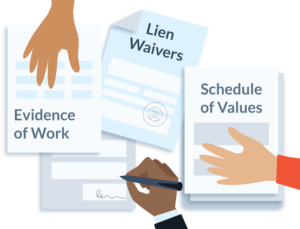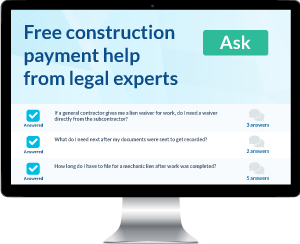
For most projects, a simple invoice is all you need to submit in order to get paid. On larger projects, particularly in commercial construction, there may be additional documents that you need to turn in along with an invoice. This packet of information is called a payment application. Additional documentation is a good thing, but it can be a lot of extra work for the person collecting and organizing the documents. This work is compounded when there is a problem with a pay application and the GC redlines or rejects it. Payment application mistakes can have serious consequences for a subcontractor’s cash flow. We’ll show you some of the most common mistakes and tell you how to fix them.
What is a payment application?
A pay application is the packet of documents that subcontractors submit to a GC or an owner and serves as a request for payment. Contractors also refer to it as a “pay app,” “payment application,” or similar. Generally, only second-tier subcontractors will need to submit one.
While an invoice itself is technically a request for payment, commercial or large construction projects usually require more paperwork. There’s a lot of money on the line – the parties that control payment on a project want complete documentation of the work to make sure they’re not wasting money.
A payment application packet may contain any or all of the following:
- Application form
- Invoice
- Receipts
- Backup documentation (photos, etc.)
- Lien waivers
- Change orders
- Payroll reports
To make things even more confusing, different GCs want subs to include different documents for a pay application. Requirements can vary by project and by company. For subs, especially those that work on a number of projects at once, document organization is important.
Common payment application forms
While each contractor, owner, or financial institution may require different documents and forms for each project, there are some standard forms that are generally accepted across the industry. Once you figure out how to use these, most of the other forms out there will seem familiar.
American Institute of Architects (AIA)
You may hear this form called an “AIA form,” “G702,” or a progress billing form. It is a template furnished by the AIA for the use of its members and others in the industry. The AIA charges for each use of the form, which can get expensive fast. While the AIA payment application (G702) is a single form, it’s usually submitted with the AIA Change Order form (G701) and Continuation Sheet (G703). You will usually need all of the sheets for a complete application.
The payment application gives a summary of the current contract value, how much has been billed to date, and how much is due with this payment application. It is also where the contractor and architect sign off on the amounts, and it serves as a receipt of payment. The continuation sheet is where you break down the work into its component parts (schedule of values) and the progress on each line item is recorded each month. Any changes to the scope of work go in the change order form. Together the documents allow the reviewer to get a feeling for how much of the work is complete, how much has been paid for, and how much is still left to complete.
ConsensusDocs
ConsensusDocs is another common payment application. They created their construction documents through collaboration between parties at every level on a construction project. There are contracts, pay applications, change orders, and other construction-related forms available. There is a cost to download each form template.
Alternatives
You can find free or low-cost pay applications online that use Excel or Google Sheets, and many software packages have adapted this form into their programming.Levelset has a free payment application summary sheet (like the AIA G702) with fields for the same information in a simplified form. (We also organize, manage, and track pay applications for customers across all of their projects.)
Video: 5 Common Pay App Mistakes
5 Common Payment Application Mistakes
Read your contract carefully, and understand what information the GC requires in your pay application. When preparing the application, pay close attention to detail. Be thorough. Making a mistake on a pay app can mean you have to wait until the next billing cycle to get paid.
1. Missing the application deadline.
This is one of the most critical aspects of submitting a payment application. Read your contracts carefully. Some GCs may send additional instructions that tell you exactly what forms to turn in, where to send them, and when they must be turned in. If you aren’t sure when the deadline is, reach out to the GC’s or owner’s accounting department and find out.
2. Overbilling.
While it sounds like a good idea to bill a bit extra to cover future expenses or a tax bill you have coming up, billing over your actual percent complete can create problems for everyone.
First, your invoice may be rejected when it is reviewed further up the chain. Some GCs may not allow you to appeal your case or revise your invoice, they may just reject it outright, leaving you with no income for that month.
Second, if your invoice is approved and paid, it can leave you short of cash later in the project. You want to make sure you are covering your current expenses at all phases of the project.
And third, if you are producing financial statements that are based on your work-in-progress, you will be penalized for overbilling on a project, potentially lowering your net income for the period. It’s best to bill as close to your true percent complete as possible.
3. Forgetting backup documents.
When it comes time to submit your first pay app on a project, reach out to the GC or owner to see exactly what documents are required. Read your contract and any additional documents provided by the GC to see if they spell out what their expectations are. Try not to get too upset if they send your first application back with a request for additional documents. Sometimes the GC isn’t aware of all the requirements themselves. The first couple of draws on a project usually take a bit longer, as everyone gets used to the documentation requirements of the property owner or lender.
4. Bad math.
It happens. Everyone forgets to carry the 2 sometimes. When putting together a payment application, it is best to double- and triple-check your records and your math to make sure everything adds up like it is supposed to. Check contract amounts, previous billing amounts, and change orders. Use your accounting software or a spreadsheet with formulas for improved accuracy. Some GCs may be forgiving and correct your errors for you, but some just don’t have time to fix them, and will choose to reject your invoice instead. Make sure the amounts match on all the documents you turn in.
5. Billing for unapproved change orders.
Most GCs will tell you that they will not accept an invoice for change orders that haven’t been officially issued. If you’ve done extra work that you need to get paid for, talk to the GC about it first. Let the GC know that you have change orders that need approval. Ask if you can bill for them even without a formal change order (some GCs will let you if you ask).
Most GCs will try to work with you, or at least let you know if there is a problem. The biggest mistake is to send an invoice for a bunch of extra work that the GC knows nothing about. Make sure they are aware of all extra work before it is performed. If they don’t want to issue a change order, try to document their approval before starting. If there is a dispute about additional work, protect your lien rights and follow the conflict resolution processes in your contract.
What happens if a payment application is rejected?
If a GC rejects your pay app, they should communicate with you in some way. Ask if you can resubmit your application to fix the errors and get your payment approved. If they say that you can resubmit, do so as quickly as possible. The GC may also say that you must wait until next month to resubmit. You will then have to activate a cash flow backup plan.
If you haven’t heard from the GC on the status of your payment application in about five days, follow up with them to make sure everything is in order and your invoice has been approved. If there is a problem, work quickly to resolve it and get the information turned in.
Always make sure that you are protecting your payment rights. This means filing a preliminary notice, monthly notices, or other documents as required by your state. Try to work things out if there is an issue, but use the tools provided by the contract and state statutes to protect your lien rights and make sure you get paid for the work you have performed.


